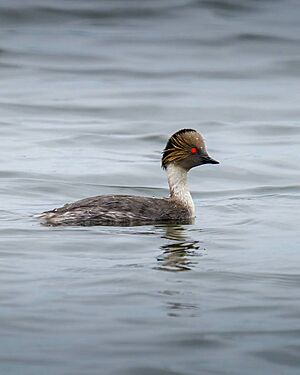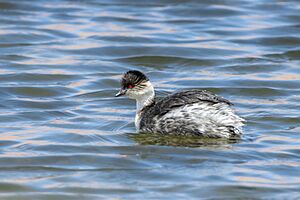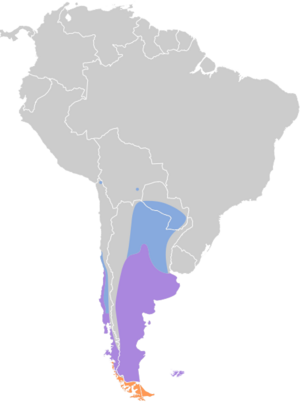Silvery grebe facts for kids
Quick facts for kids Silvery grebe |
|
|---|---|
 |
|
 |
|
| Southern silvery grebe (top), Northern silvery grebe (bottom) |
|
| Conservation status | |
| Scientific classification | |
| Genus: |
Podiceps
|
| Species: |
occipitalis
|
 |
|
| Range of southern silvery grebe (not including northern silvery grebe, see text) | |
The silvery grebe (Podiceps occipitalis) is a type of grebe, which is a diving water bird. You can find these birds in the western and southern parts of South America. They love living in lakes and other open wet areas. There are two main types, or subspecies, of silvery grebes. Some experts even think these two types should be considered completely separate species!
Contents
About the Silvery Grebe
The silvery grebe is a medium-sized bird, usually about 28 centimeters (11 inches) long. It has a black crown on its head, and its neck, chest, and belly are white. Its back is dark grey, and its sides are blackish. The beak and feet are black, and its eye is red.
Different Types of Silvery Grebes
There are two main subspecies of the silvery grebe. They look a bit different, especially in the colors on their heads and the special feathers around their ears.
- Northern silvery grebe (P. o. juninensis): This type lives high up in the Andes mountains, between 3,000 and 5,000 meters (about 9,800 to 16,400 feet) above sea level. You can find them from Colombia all the way down to northern Argentina and Chile. The northern silvery grebe has grey ear feathers and its throat and sides of its head are white.
- Southern silvery grebe (P. o. occipitalis): This type lives at lower altitudes, up to 1,500 meters (about 4,900 feet). They are found in central and southern parts of Chile and Argentina, and also in the Falkland Islands. The southern silvery grebe has yellowish ear feathers, and its throat and sides of its head are grey. These birds sometimes travel north for winter to places like southern Brazil, southern Bolivia, and Paraguay.
The northern silvery grebe looks quite a lot like another rare bird called the Junin grebe. Both birds can be found in the same areas.
Where Silvery Grebes Live
Silvery grebes build their nests in countries like Argentina, the Falkland Islands, Chile, and the western parts of Bolivia, Peru, Ecuador, and Colombia.
These birds prefer freshwater lakes, lagoons, and ponds. In the Andes mountains, they often choose lakes that are slightly alkaline (not too acidic). Sometimes, they even look for food in very salty lakes. In a region called Patagonia, you might see them in salty lakes alongside flamingoes!
What Silvery Grebes Eat and How They Live
Silvery grebes usually live in small groups. They are skilled divers and catch their food underwater. Their diet mainly consists of small water creatures without backbones, called aquatic invertebrates. This includes adult and young caddisflies, water beetles, tiny midges, and water boatmen.
Reproduction and Nesting
Silvery grebes often build their nests in groups, forming colonies on lakes. Their nests are usually made from floating mats of plants. In Colombia, they have been seen nesting in February. In Peru, nesting happens between September and March, with most eggs laid from November to January.
Conservation Status
The IUCN (International Union for Conservation of Nature) looks at how many of these birds are left in the wild. They consider the southern silvery grebe to be of "Least Concern", meaning it's not currently in danger of disappearing. However, the northern silvery grebe is listed as "Near Threatened", which means its population is getting smaller and it might become endangered in the future.
Even though both types of silvery grebes live in large areas, their numbers are going down. This is mainly because their homes (habitats) are being lost or damaged. Sometimes, hunting also affects them, and new animal species introduced to their areas can cause problems too.



